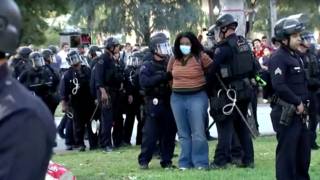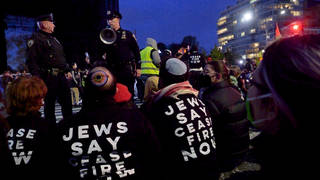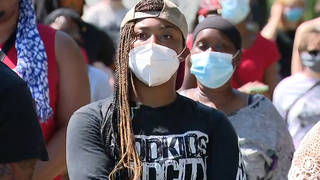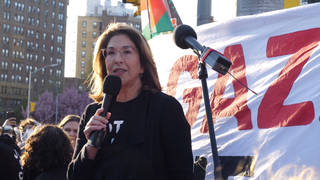
Related
Guests
- Mateo Zapataindependent journalist, photographer and community organizer in Chicago.
- Lilia Fernándezassociate professor at Rutgers University, where she teaches Latino and Caribbean studies and history.
As protests continue in Chicago and nationwide over the police killing of 13-year-old Adam Toledo, we get an update from community activist and independent journalist Mateo Zapata, who says, “People in Chicago are just tired of seeing Black and Brown youth murdered by police.” Released bodycam video showed Adam had his hands up in the air when he was shot by an officer. We also speak with Rutgers professor Lilia Fernández, who studies Latino Chicago history and says police brutality toward this community is “not a new phenomenon” and goes back many decades. “Adam Toledo would not be dead today if he were white, if he were from an affluent family or if he lived in a predominantly white neighborhood,” Fernández says.
Transcript
AMY GOODMAN: Protests are continuing in Chicago over the police killing of 13-year-old Adam Toledo. Police bodycam video released Thursday shows Adam had his empty hands up in the air when he was shot by an officer on March 29th. Adam was a seventh grader at Gary Elementary School. The Chicago police initially described the incident as an “armed confrontation,” but the video shows Adam raised his hands after being ordered to do so after a short chase. Police were investigating reports of gunfire in the area.
Amid nationwide protests over his killing, thousands marched Sunday in Chicago’s Little Village, the largely Mexican neighborhood where Adam was killed. Two days earlier, on Friday, thousands gathered in Chicago’s Logan Square. Some held signs reading, quote, “My Hands Are Up. Don’t Shoot.” Protesters blasted authorities for trying to cover up the circumstances of Adam’s death.
Meanwhile, James Murphy, a longtime prosecutor in Cook County has been placed on administrative leave after he falsely told a judge that Toledo was holding a gun when police shot him. In a statement, Cook County State’s Attorney Kim Foxx’s office said Murphy had, quote, “failed to fully present the facts surrounding the death of a 13-year-old boy.”
Over the weekend, Democratic state lawmaker Edgar Gonzalez Jr. criticized the police for being too willing to shoot.
REP. EDGAR GONZALEZ JR.: If you put your hands up, they shoot. If you put your hands down, they shoot. If you walk, you run, you hide, you sleep, you do exactly as they say, they still shoot.
AMY GOODMAN: We’re joined now by two guests. Lilia Fernández is a native Chicagoan, associate professor of Latino and Caribbean studies and history at Rutgers University. She’s the author of the book Brown in the Windy City: Mexicans and Puerto Ricans in Postwar Chicago, is currently writing a new book titled A History of Latino Chicago: Class Solidarities and Coalitional Politics. And Lilia is married to Democracy Now! co-host Juan González. In Chicago, we’re joined by Mateo Zapata, an independent journalist, photographer and community organizer. He recently wrote an op-ed for the Chicago Tribune titled “We are Adam: For many youth across Chicago’s South and West sides, Adam Toledo’s life trajectory is too familiar.”
We welcome you both to Democracy Now! Mateo, you’ve been in the streets of Chicago this weekend covering the protests. Talk about the issues being raised and the original circumstances of this 13-year-old boy Adam Toledo’s death.
MATEO ZAPATA: Good morning.
The original circumstances surround the fact that the Chicago Police Department actively tried to cover up everything about this case, and COPA also tried to delay the release of the footage. And —
AMY GOODMAN: COPA is?
MATEO ZAPATA: COPA is the police accountability entity in Chicago. So they’re responsible for handling all of the evidence and processing everything around people that are murdered by police.
AMY GOODMAN: So, the murder happened at the end of March, but it took a few weeks for this video to be released. So the police and the city shaped the narrative at the beginning.
MATEO ZAPATA: Yeah, no, I mean, the pro-police narrative has been in full effect. And, you know, there’s been just a lot of demonizing happening in regards to who Adam was and the circumstances of how he was murdered. And, you know, what we’ve seen in Chicago is just the police department here is developing a culture of killing people during foot pursuits. You know, three days after Adam was murdered, they shot and killed Anthony Alvarez, who was also running. And last year they killed Marc Nevarez in that same neighborhood of Little Village when he was running, as well. Within Adam’s circumstances and everything surrounding his murder, what we saw is he complied. He had his hands up, and they were empty, and he was still murdered. And so, you know, people in Chicago are just tired of seeing Black and Brown youth murdered by police.
AMY GOODMAN: Profess —
MATEO ZAPATA: And — yeah.
AMY GOODMAN: Let me bring Professor Fernández into this discussion. You’ve been following this very closely from the beginning, albeit from afar. Talk about what happened, when you saw that video, at the end, when the police officer says, “Hold up your hands and turn around” — exactly what Adam did.
LILIA FERNÁNDEZ: Thank you for having me, Amy. And I wish it were under better circumstances.
But watching that video was absolutely heart-wrenching. You know, we have been traumatized over and over again, to say nothing of the families of these victims, watching the killing of 12-year-old Tamir Rice, 13-year-old Tyre King, 17-year-old Laquan McDonald. That’s who I immediately thought of when I saw this video footage of Adam Toledo — young people, innocent teenagers, who had no idea that their lives were about to be taken from them by these officers. So, it’s devastating. It’s absolutely devastating.
But I will say also that, you know, we have seen a lot of attention to the killings of African Americans recently. Adam Toledo is Mexican American, I believe. And I’m glad that we’re finally getting some national attention on police brutality and killings of Latinos. This has been going on for far too long. I can say more about that, about the history of police brutality and police killings of Latinos, not only in Chicago, but in other cities around the country.
AMY GOODMAN: Why don’t you talk about that now?
LILIA FERNÁNDEZ: Sure. Well, you know, as I said, this is not a new phenomenon. You know, going back even to the 1920s, Mexican immigrants in Chicago complained about the prejudiced treatment that they received from police officers compared to how they treated Polish immigrants, for example. But most of the examples I’ve looked at are from the '50s and ’60s. That's really when the Latino or Latinx population began to grow in Chicago with the influx of Mexican Americans, Mexican immigrants and Puerto Ricans. And many Chicago residents and police did not like this, the fact that these populations were moving in, and moving into some predominantly white neighborhoods.
Ever since then, we’ve seen countless examples of different kinds of police brutality and abuse. Even the famed oral historian Studs Terkel documented a Puerto Rican man, Carlos Alvarez, reporting that police fractured his arm when he was coming off of his night shift as a watchman at a museum. Other men, like Celestino González and Silvano Burgos — this is all in the 1960s, by the way — gave accounts of brutal police beatings in a police station in 1965. The shooting of 20-year-old Arcelis Cruz, a Puerto Rican youth, in the Humboldt Park neighborhood in June of 1966 is what set off the Division Street uprising that year. And the rest of that summer, there were a number of other shootings and beatings of Latino men — 15-year-old Nelson Rivera, who was shot and killed in Woodlawn, the Woodlawn neighborhood, for stealing a car; Ismael Laboy, who was killed by police in front of his wife and eight children. And the list goes on and on.
What’s clear is that, over the decades, the different calls from activists and community leaders for reforms have not changed this problem. This is an intractable issue. And I think we need to understand the deep origins of it to really effect the kind of reform or systemic changes that are needed.
AMY GOODMAN: The Toledo family’s attorney, Adeena Weiss-Ortiz, described the killing as an “assassination” during a press conference last week. This is what she said.
ADEENA WEISS-ORTIZ: By now, all of you have seen the videos of Adam Toledo. They are especially moving, saddening, distressful, to see a 13-year-old boy shot at the hands of an officer. For those of you with children, you can relate to some of the pain that the Toledos are feeling today. Those videos speak for themselves. Adam, during his last second of life, did not have a gun in his hand. The officer screamed at him, “Show me your hands!” Adam complied, turned around. His hands were empty when he was shot in the chest at the hands of the officer. He did not have a gun in his hand, contrary to the reports made earlier today.
AMY GOODMAN: That’s the Toledo family attorney, Adeena Weiss-Ortiz, speaking last week about the killing of Adam, a 13-year-old seventh grader at Gary Elementary School. Mateo Zapata, you’ve been writing about Adam’s story. Can you tell us about where he grew up, about his school, about how he was separated from other students, and more?
MATEO ZAPATA: Yeah. He grew up on the South Side of Chicago in the Westlawn neighborhood. He had barely been in Little Village for about a year. And he was labeled a SPED student early on, but he didn’t have any severe learning disabilities at all. But he was still marginalized and separated. So, the educators that I spoke with, his former teachers, said that they didn’t feel that he really had the opportunity to develop his social and emotional intelligence.
And I think that’s a situation that a lot of youth in Chicago’s public school system deal with. Even myself, I was kicked out of school when I was younger, as well. And I think that Adam, having been so young, still had an opportunity to have some of whatever was going on be addressed, but it wasn’t. And I think that the Chicago public school system needs to have a serious moment of reflection on how it treats its inner-city students.
AMY GOODMAN: You spoke to several of Adam’s teachers. And as we speak, Mateo, you’re a video journalist, and we’ve been running some of the video of the protests over the weekend that you took. Tell us what his teachers said.
MATEO ZAPATA: The teachers said that, you know, he was really passionate about art. He really liked to draw a lot. That was like his gift. That was his thing, you know? And the teacher felt that if there was the resources or the programming to explore arts education, that that could have been a means for Adam to utilize his energy in a more constructive manner. Specifically in Little Village throughout the last two decades, it’s been studied as being one of the areas in Chicago that has the largest group of what’s called disconnected youth. So, it’s groups of young people that live in these neighborhoods that aren’t enrolled in any sort of academic institution and are also unemployed.
AMY GOODMAN: So, Professor Fernández, talk about the narrative before we saw the video, because people might be surprised to see that Adam was killed by the police at the end of March, that the uprising is just happening now, but that’s because the video footage wasn’t released. And at this point, even an attorney within the city has been suspended for misrepresenting what was in that video before we saw it, saying that Adam had a gun in his hand.
LILIA FERNÁNDEZ: That’s right. Chicago police and Assistant State’s Attorney James Murphy knew for more than two weeks that this police shooting looked dreadful. And so they began to craft the narrative to justify it, claiming that this was first an “armed confrontation,” quote-unquote, that Toledo was holding a gun when he was shot. They kept emphasizing the ShotSpotter technology, which saturates poor Black and Brown communities in Chicago, and other kinds of video surveillance and militarized technology that’s supposed to reduce crime.
And they also noted, in an editorial — the Chicago Tribune, in an editorial recently, tried to make the connection to Ruben Roman’s — somehow implicating him, that he was ultimately responsible for Toledo’s death. So —
AMY GOODMAN: And explain who he was, the 21-year-old.
LILIA FERNÁNDEZ: Yes. Ruben Roman was the 21-year-old who was allegedly in Toledo’s company and who presumably was the owner of the gun that police claim was being fired and that they claim Toledo had in his possession.
However, we know that these kinds of narratives that the police and state’s attorney’s offices craft, you know, they’re always the same. They’re always depicting victims of police violence as either the bad guys, the criminals, or simply collateral damage in police pursuit of the bad guys. Black and Latino communities do not commit any more crimes than white Americans do, and yet it’s precisely those neighborhoods that are overpoliced, and it’s precisely the crime that occurs in those neighborhoods that we focus on.
We have to ask ourselves, as a society: Why don’t we look more carefully or think more about other kinds of crimes that are committed, that happen every day in this country — corporate crimes, companies that pollute and are destroying our environment and our communities, political leaders who commit fraud and embezzlement and, you know, rob public coffers of millions of dollars, people who distribute child pornography? None of that crime ever comes into the conversation. Instead, what we always focus on is drugs and violent crime in poor, working-class communities, where many residents who are not able to find employment in the regular labor market go into the informal economy.
You know, lastly, I’ll say that Adam Toledo would not be dead today if he were white, if he were from an affluent family, or if he lived in a predominantly white neighborhood.
AMY GOODMAN: And finally, Mateo, on Sunday morning, the mayor, Lightfoot, posted a series of tweets to her personal Twitter account addressing unsubstantiated rumors that she would resign as Chicago mayor on — that was Sunday morning. Your thoughts?
MATEO ZAPATA: Lori Lightfoot is a liar, and she’s a cop. And she has been extremely oppressive towards Black and Brown communities since she got into office. If you remember the video of the police raid on Anjanette Young’s house, she tried to suppress that bodycam footage to come out. So, she is not in any way or position someone who should ever speak on behalf of Black or Brown communities in Chicago.
She gave over half of our federal COVID relief funds to the Chicago Police Department. That’s over $280 million that she gave to CPD as our federal COVID relief, that we should have had in Black and Brown communities, that were the most impacted during the pandemic. The people that had the highest death rates, contraction rates, the essential workers in this city, they are predominantly in Black and Brown communities. So that’s where the COVID relief funding needed to be. So, Lori Lightfoot, she definitely needs to resign, and she should no longer be the mayor of Chicago.
AMY GOODMAN: Lori Lightfoot, before she was mayor, was president of the Chicago Police Board and chair of the Chicago Police Accountability Task Force. Where do you see these protests going, Mateo?
MATEO ZAPATA: I think that the protests will likely continue. I think that aside from the marching, aside from the protests, I think we really need to look at instituting some kind of policy in regards to foot pursuits in Chicago specifically. Right now there is no policy. And that’s something that I already know a few people around the South Side that have worked at raising awareness on how police terrorize our communities were starting to seriously consider the need to institute some sort of foot pursuit policy, because we cannot continue to allow the Chicago Police Department to kill Black and Brown people in our communities when they are running away.
AMY GOODMAN: And is there any discussion, any word about the charging of the police officer who killed Adam?
MATEO ZAPATA: No. As of now, I have not heard of any charges being brought up on officer Eric Stillman, who murdered Adam Toledo, with his hands up, while he was unarmed. Right now —
AMY GOODMAN: Final word, Professor Fernández?
MATEO ZAPATA: Yeah.
LILIA FERNÁNDEZ: Yes. I think that we need to look very seriously at the long history of this intractable problem. You know, in the '50s and ’60s, when the community complained about police abuse and violence, they said it was a language barrier issue, and so they sent cops to learn Spanish. In the ’70s, they said, “We don't have enough Hispanic police on the force,” and so they started to demand hiring of more Latino officers. In the ’80s and ’90s, of course, we talked more about accountability, then the body cameras. Now we have these body cameras and all this technology, and still the police culture of disdain and even contempt for Brown people, for Black people, for nonwhite people, and particularly for poor people, continues to permeate both law enforcement and the criminal justice system.
So, this requires a complete overhaul. And we need to think big. We need to work in solidarity with one another, understand that, as the recent violence against Asian Americans has shown, that racism — that we have a problem beyond anti-Black racism, but also racism against Brown people, Asian Americans and others.
AMY GOODMAN: Lilia Fernández, we want to thank you for being with us, Rutgers University professor, native Chicagoan, author of Brown in the Windy City: Mexicans and Puerto Ricans in Postwar Chicago, writing a second book titled A History of Latino Chicago: Class Solidarities and Coalitional Politics. And thanks so much to Mateo Zapata, independent journalist, photographer and community organizer. We’ll link to both of your books, your articles, at democracynow.org.
Next up, a lieutenant in the Army Medical Corps is suing two Virginia police officers who pepper-sprayed him, pushed him to the ground, pointed their guns at his head, during a traffic stop. We’ll speak with his lawyer. Stay with us.












Media Options